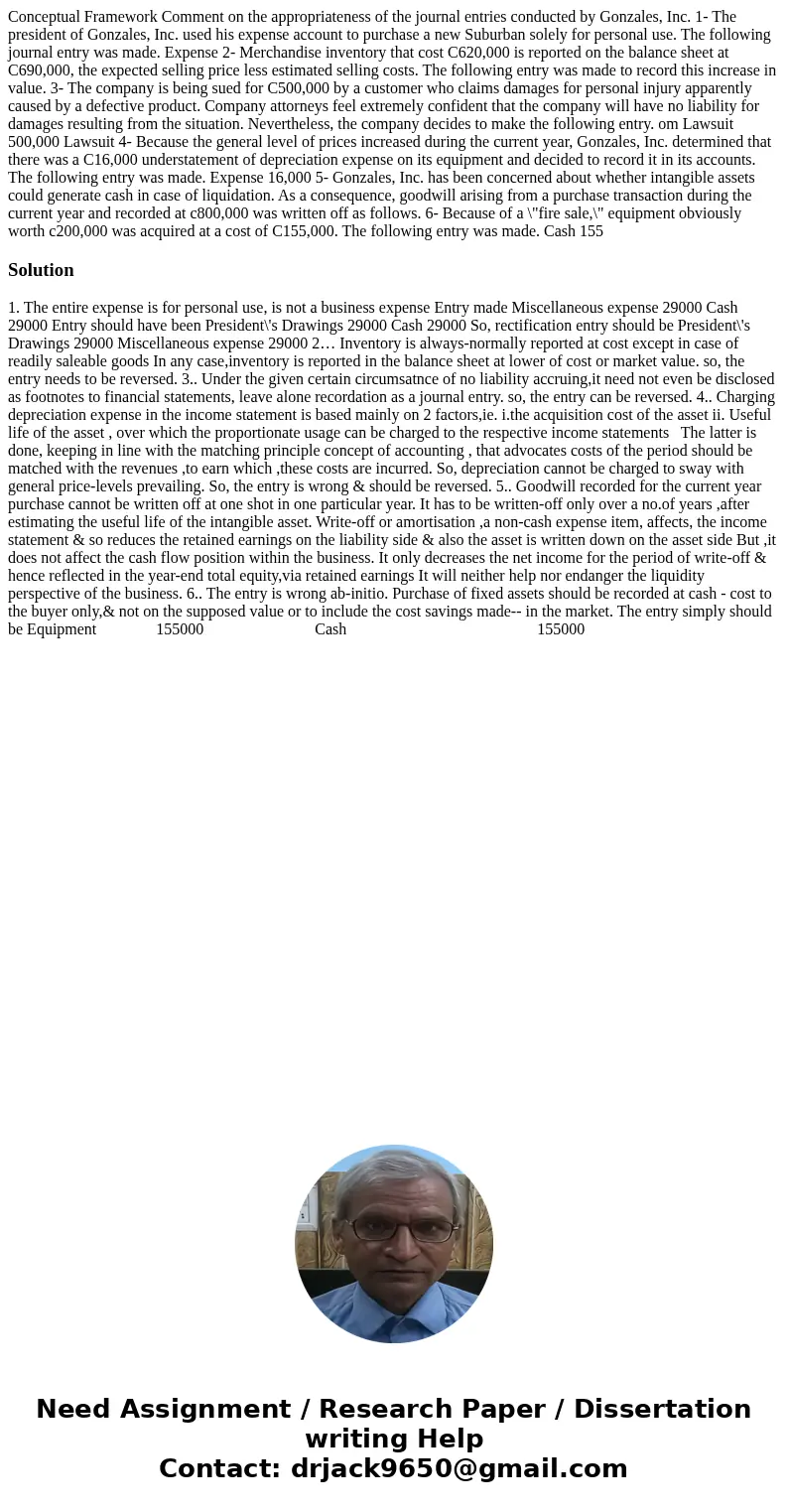Conceptual Framework Comment on the appropriateness of the j
Conceptual Framework Comment on the appropriateness of the journal entries conducted by Gonzales, Inc. 1- The president of Gonzales, Inc. used his expense account to purchase a new Suburban solely for personal use. The following journal entry was made. Expense 2- Merchandise inventory that cost C620,000 is reported on the balance sheet at C690,000, the expected selling price less estimated selling costs. The following entry was made to record this increase in value. 3- The company is being sued for C500,000 by a customer who claims damages for personal injury apparently caused by a defective product. Company attorneys feel extremely confident that the company will have no liability for damages resulting from the situation. Nevertheless, the company decides to make the following entry. om Lawsuit 500,000 Lawsuit 4- Because the general level of prices increased during the current year, Gonzales, Inc. determined that there was a C16,000 understatement of depreciation expense on its equipment and decided to record it in its accounts. The following entry was made. Expense 16,000 5- Gonzales, Inc. has been concerned about whether intangible assets could generate cash in case of liquidation. As a consequence, goodwill arising from a purchase transaction during the current year and recorded at c800,000 was written off as follows. 6- Because of a \"fire sale,\" equipment obviously worth c200,000 was acquired at a cost of C155,000. The following entry was made. Cash 155 
Solution
1. The entire expense is for personal use, is not a business expense Entry made Miscellaneous expense 29000 Cash 29000 Entry should have been President\'s Drawings 29000 Cash 29000 So, rectification entry should be President\'s Drawings 29000 Miscellaneous expense 29000 2… Inventory is always-normally reported at cost except in case of readily saleable goods In any case,inventory is reported in the balance sheet at lower of cost or market value. so, the entry needs to be reversed. 3.. Under the given certain circumsatnce of no liability accruing,it need not even be disclosed as footnotes to financial statements, leave alone recordation as a journal entry. so, the entry can be reversed. 4.. Charging depreciation expense in the income statement is based mainly on 2 factors,ie. i.the acquisition cost of the asset ii. Useful life of the asset , over which the proportionate usage can be charged to the respective income statements The latter is done, keeping in line with the matching principle concept of accounting , that advocates costs of the period should be matched with the revenues ,to earn which ,these costs are incurred. So, depreciation cannot be charged to sway with general price-levels prevailing. So, the entry is wrong & should be reversed. 5.. Goodwill recorded for the current year purchase cannot be written off at one shot in one particular year. It has to be written-off only over a no.of years ,after estimating the useful life of the intangible asset. Write-off or amortisation ,a non-cash expense item, affects, the income statement & so reduces the retained earnings on the liability side & also the asset is written down on the asset side But ,it does not affect the cash flow position within the business. It only decreases the net income for the period of write-off & hence reflected in the year-end total equity,via retained earnings It will neither help nor endanger the liquidity perspective of the business. 6.. The entry is wrong ab-initio. Purchase of fixed assets should be recorded at cash - cost to the buyer only,& not on the supposed value or to include the cost savings made-- in the market. The entry simply should be Equipment 155000 Cash 155000
 Homework Sourse
Homework Sourse